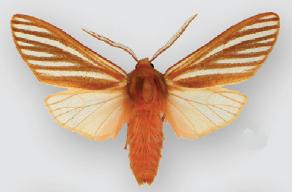Ammalo is a genus of moths in the subtribe Phaegopterina in the family Erebidae. The genus was erected by Francis Walker in 1855.
Cresera is a genus of moths in the family Erebidae. The genus was described by Schaus in 1894.
Elysius is a genus of moths in the family Erebidae. The genus was erected by Francis Walker in 1855.
Histoea is a genus of moths in the subfamily Arctiinae. The genus was erected by Francis Walker in 1854.
Hyaleucerea is a genus of moths in the subfamily Arctiinae. The genus was erected by Arthur Gardiner Butler in 1875.
Lepidolutzia is a monotypic moth genus in the family Erebidae described by Rego Barros in 1956. Its only species, Lepidolutzia baucis, was first described by Johan Wilhelm Dalman in 1823. It is found on Cuba, Bolivia and the Brazilian state of Pará.
Lepypiranga is a monotypic moth genus in the family Erebidae and subfamily Arctiinae described by Rego Barros in 1966. Its only species, Lepypiranga albiceps, was described by Rothschild in 1933. It is found in Brazil.
Machadoia is a genus of moths in the family Erebidae. The genus was described by Rego Barros in 1956 and contains three species found in Ecuador and Brazil.
Mellamastus is a monotypic moth genus in the family Erebidae described by Rego Barros in 1959. Its only species, Mellamastus nero, was first described by Gustav Weymer in 1907. It is found in Brazil.
Pareuchaetes is a genus of moths in the family Erebidae. The genus was erected by Augustus Radcliffe Grote in 1866.

Pseudohemihyalea is a genus of moths in the family Erebidae described by Régo Barros in 1956. While the caterpillars of most species of Pseudohemihyalea feed on broad-leaved trees, the P. ambigua group has larvae that feed on conifers. Their forewing coloration has accordingly evolved to light-and-dark lengthwise striping, giving better camouflage among the slim needles of the host plants. In this, they seem to be convergent to certain geometer moths, such as Caripeta piniata or Sabulodes niveostriata.
Pseudohyaleucerea is a genus of moths in the subfamily Arctiinae. The genus was described by Régo Barros and Machado in 1971.
Mielkesia is a genus of moths in the family Saturniidae first described by Lemaire in 1988.
Cresera espiritosantensis is a moth of the family Erebidae. It was described by Rego Barros in 1958. It is found in southern Brazil.
Cresera tinguaensis is a moth of the family Erebidae. It was described by Rego Barros in 1957. It is found in Brazil.
Elysius amapaensis is a moth of the family Erebidae. It was described by Rego Barros in 1971. It is found in Brazil.
Elysius itaunensis is a moth of the family Erebidae. It was described by Rego Barros in 1971. It is found in Brazil.
Leucanopsis malodonta is a moth of the family Erebidae, and was described by Harrison Gray Dyar Jr. in 1914. Leucanopsis malodonta can be found in Peru.
Leucanopsis vangetta is a moth of the family Erebidae. It was described by Harrison Gray Dyar Jr. in 1910. It is found in Mexico.
Pareuchaetes pseudoinsulata is a moth of the subfamily Arctiinae. It was described by Alfredo Rei do Régo Barros in 1956. It is found in Venezuela and Trinidad. It is an introduced species in Sri Lanka, as well as on Sabah, Borneo, Palawan and Guam.